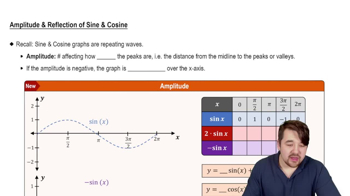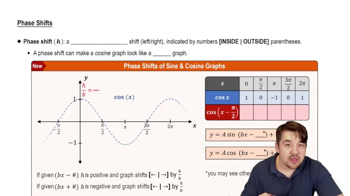Table of contents
- 0. Review of College Algebra4h 43m
- 1. Measuring Angles39m
- 2. Trigonometric Functions on Right Triangles2h 5m
- 3. Unit Circle1h 19m
- 4. Graphing Trigonometric Functions1h 19m
- 5. Inverse Trigonometric Functions and Basic Trigonometric Equations1h 41m
- 6. Trigonometric Identities and More Equations2h 34m
- 7. Non-Right Triangles1h 38m
- 8. Vectors2h 25m
- 9. Polar Equations2h 5m
- 10. Parametric Equations1h 6m
- 11. Graphing Complex Numbers1h 7m
4. Graphing Trigonometric Functions
Graphs of the Sine and Cosine Functions
Problem 23aBlitzer - 3rd Edition
Textbook Question
In Exercises 17–30, determine the amplitude, period, and phase shift of each function. Then graph one period of the function. y = 1/2 sin(x + π/2)
 Verified step by step guidance
Verified step by step guidance1
Identify the standard form of the sine function:
Determine the amplitude by identifying the coefficient
Find the period of the function using the formula
Calculate the phase shift using
Graph one period of the function by starting at the phase shift
Recommended similar problem, with video answer:
 Verified Solution
Verified SolutionThis video solution was recommended by our tutors as helpful for the problem above
Video duration:
7mPlay a video:
Was this helpful?
Key Concepts
Here are the essential concepts you must grasp in order to answer the question correctly.
Amplitude
Amplitude refers to the maximum height of a wave from its midline. In the context of sine functions, it is determined by the coefficient in front of the sine term. For the function y = 1/2 sin(x + π/2), the amplitude is 1/2, indicating that the wave oscillates between 1/2 and -1/2.
Recommended video:

Amplitude and Reflection of Sine and Cosine
Period
The period of a trigonometric function is the length of one complete cycle of the wave. For sine functions, the standard period is 2π. However, if the function includes a coefficient affecting the x variable, the period is calculated as 2π divided by that coefficient. In this case, the period remains 2π since there is no coefficient affecting x.
Recommended video:

Period of Sine and Cosine Functions
Phase Shift
Phase shift refers to the horizontal displacement of a wave from its standard position. It is determined by the value added or subtracted from the x variable inside the function. For y = 1/2 sin(x + π/2), the phase shift is -π/2, meaning the graph is shifted to the left by π/2 units.
Recommended video:

Phase Shifts

 5:53m
5:53mWatch next
Master Graph of Sine and Cosine Function with a bite sized video explanation from Nick Kaneko
Start learningRelated Videos
Related Practice
Textbook Question
In Exercises 1–6, determine the amplitude of each function. Then graph the function and y = sin x in the same rectangular coordinate system for 0 ≤ x ≤ 2π.
y = 4 sin x
375
views
